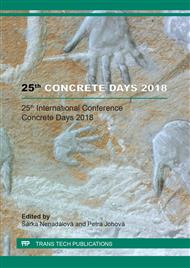[1]
A. Neville: Properties of Concrete (Prentice Hall, New Jersey 2012).
Google Scholar
[2]
EN 1992-1-1: Eurocode 2: Design of concrete structures - Part 1-1: General reles and rules for buildings, (2006).
Google Scholar
[3]
P. Misák, D. Kocáb, P. Daněk, B. Kucharczyková and L. Topolář: MATEC Web of Conferences Vol 107 (2017), pp.1-5.
DOI: 10.1051/matecconf/201710700038
Google Scholar
[4]
EN 12390-13: Testing hardened concrete - Part 13: Determination of secant modulus of elasticity in compression, (2014).
DOI: 10.3403/30397532
Google Scholar
[5]
EN 12350-5: Testing fresh concrete - Part 5: Flow table test, (2009).
Google Scholar
[6]
EN 12350-6: Testing fresh concrete - Part 6: Density, (2009).
Google Scholar
[7]
EN 12390-1: Testing hardened concrete - Part 1: Shape, dimensions and other requirements for specimens and moulds, (2013).
DOI: 10.3403/30254400
Google Scholar
[8]
EN 12390-3: Testing hardened concrete - Part 3: Compressive strength of test specimens, (2009).
Google Scholar
[9]
EN 12390-6: Testing hardened concrete - Part 6: Tensile splitting strength of test specimens, (2010).
DOI: 10.3403/30200045
Google Scholar
[10]
EN 12390-7: Testing hardened concrete - Part 7: Density of hardened concrete, (2009).
Google Scholar
[11]
ČSN 73 1371: Non-destructive testing of concrete - Method of ultrasonic pulse testing of concrete, (2011).
Google Scholar
[12]
ČSN 73 1372: Non-destructive testing of concrete - Testing of concrete by resonance method, (2012).
Google Scholar
[13]
D. Kocáb, M. Králíková, P. Cikrle, P. Misák, B. Kucharczyková, Experimental analysis of the influence of concrete curing on the development of its elastic modulus over time, Mater. Technol. 51 (2017) 657-665.
DOI: 10.17222/mit.2016.248
Google Scholar
[14]
V. Malhorta, A. N. Carino, Handbook on nondestructive testing of concrete, second ed., CRC Press, Boca Raton, (2004).
Google Scholar


